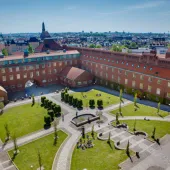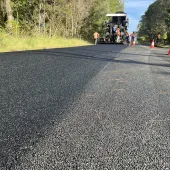Roads of the Future

First published in the July 2018 issue of Quarry Management
Preparing our roads for a changing world
By John Read, general manager specialties technology, Shell Bitumen*
The world is changing, and at Shell we look at these changes quite closely as they are important to our businesses globally, including the Shell Bitumen business. The world’s population is growing at a rapid rate with urbanization as a mega-trend. In addition, individual empowerment with digitalized and user-centered services and applications is increasing at a tremendous pace, changing the way we live and do business. Climate change is a big issue too, and whilst there are some people who still do not believe in it, at Shell we do. It is a harsh reality, but if we do not control global warming below 2oC, the impact for mankind might be catastrophic.
The way people connect is also changing; autonomous cars will soon invade our streets. Indeed, 70% of our cars may be autonomous in the very near future. But there are some who believe that we cannot mix autonomous driving and human driving; we have to make a complete shift, not just a little one. For this we will need to make vehicles capable of interacting between themselves and with other parts of the environment in which they operate, and that creates problems for our current pavements.
Addressing the needs of tomorrow’s massive urbanization
Congestion is going to be a major problem for our cities. Some 9 billion people are expected to be roaming the planet by 2030, with 70% of them living in cities. Consequently, there will be 31 mega cities by 2030, which is only 12 years away. Traffic is going to at least double if not triple, with pollution growing rapidly if we do not act. At Shell, we believe that a global carbon charge is needed, as this will help boost innovation and give us the best chance of controlling climate change to below 2oC.
Traffic noise is another one of the biggest issues in cities, and as these grow into mega cities this issue will become even greater. Safety is also key, as more traffic can generate more safety issues for pedestrians and cyclists.
Are we going to see more fatalities? The answer is yes, unless we do something. What does this mean? At Shell, we believe we need a connected ecosystem where cars, roads and traffic signage are all integrated, so they can work seamlessly and safely.
More cars will be equipped with batteries so that means that we need to equip fuel stations with the right mix of technologies: hybrid, fast battery charging, hydrogen etc. However, in terms of innovation, can we actually make a road that can generate electricity by itself and charge vehicles as people drive on them? Maybe, in the future, instead of going to a fuel station you will just drive along a section of the road that will recharge your vehicle, and you will pay a penny or cent per mile.
Who knows?
Shared access to vehicles is extremely important. This is because the way people think about vehicles is changing. Today, it is about moving people and goods from A to B. Tomorrow it will be about social connectivity. It will be about people sitting in their cars, using their mobile phones, talking to each other. The action of moving will no longer be the only reason for being in a car. So, the question could be: what else can we make roads do in addition to moving people and goods from A to B?
Roads must get better at what they do. Autonomous vehicles will be able to drive much closer to each other than we do now. So the roads’ recovery time between each passing car will decrease, meaning the damage that is done by each of these vehicles will be much higher. In addition, people will want more and more load per vehicle, which will also do more damage to the roads. Consequently, roads will have to get better at what they do: they will need to last longer; and they will have to be designed for that purpose. Today’s road designs look backward (empirical design), but they should be looking forward (analytical design) with predictive damage mechanics according to the type of traffic. If possible, they should even be self-repairing. Considering the global road network, the entire world does not have enough money to repair the roads it has today, and this network is expanding. In the past we used to design our roads for 20 years, but the average maintenance period for our roads is 80 years. So, there is already a real disconnect between the money available and the road network that we have and are developing.
Also, roads need to be safer. They should have clear binders that can glow in the dark, not only to enhance visibility, but also to reduce ambient street lighting so we can use less energy. We will need more consistent skid resistance too, because with autonomous vehicles – unless they can really sense if a road is very slippery or less slippery – consistent skid resistance will be a must in order to ensure all autonomous cars can stop when they need to.
We will also need to provide cleaner solutions, whether it is to reduce odour or to neutralize it. We will also have to use more recycled material and, finally, we will need to find less noisy solutions.
Smart and multi-skilled roads
Roads will have to get smarter. They must be able to do other things than just allow for people to move. They will be required to fight air pollution by capturing polluting particles, and generate energy by capturing solar, kinetic or piezoelectric energy. Why not use movement on the road to generate electricity and pump it out to the grid so we can reduce the amount of carbon needed to generate electricity. In the summer this could be a good way of generating money from the road network as well as reducing the heat island effect. In the winter, electricity could be converted to heat that would defrost the road so we do not have to apply winter maintenance.
Roads will also need to perform to high standards in extreme climate conditions, eg during periods of flash flooding. We need pavements to be able to take that water away and to survive much longer in these conditions. Even the 2oC climate change that is being discussed can make a huge difference in the pavement lifecycle. So, looking forward, we will need to take that into account when designing roads.
There is a lot of innovation out there but the road construction industry is still very conservative. Take polymer-modified bitumen products for example. Shell were developing these 50 years ago, yet they are still not widespread across the entire world. Innovation needs to be accepted far more quickly. The industry needs more engagement. It needs society and public stakeholders to fully endorse innovation in roads, and this needs to be initiated and come to fruition in real projects and not just talked about. We all need collaboration because no company or government can do this on its own. All stakeholders have to work together to address the issues of tomorrow’s roads and do much more than they have done in the past.
If we really want to make the roads of the future, what do we need? We need a new framework. The traditional way of contracting for our roads is not suitable for the future. It needs collaborative engagement and innovative mindsets so we can finally change our roads and deliver everything required by our society in the years to come.
*The author, John Read, gave this closing speech at the Pavement Preservation & Recycling Summit (PPRS) 2018, which took place in Nice, France, from 26–28 March.
- Subscribe to Quarry Management, the monthly journal for the mineral products industry, to read articles before they appear on Agg-Net.com








